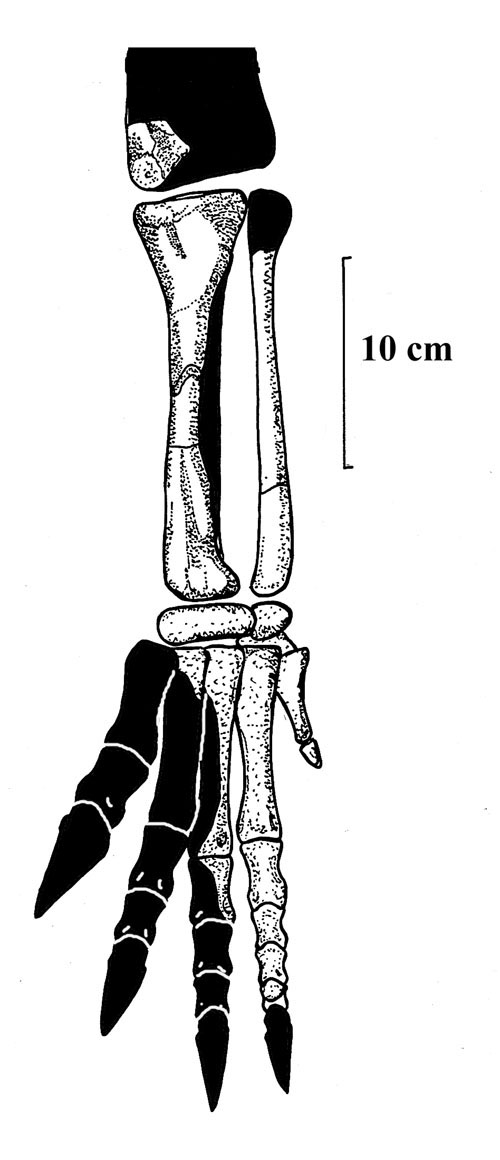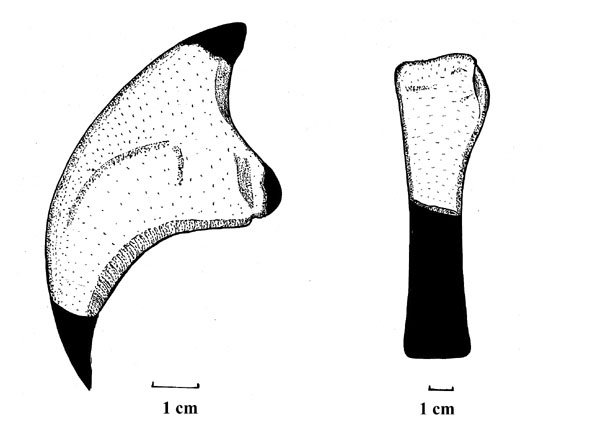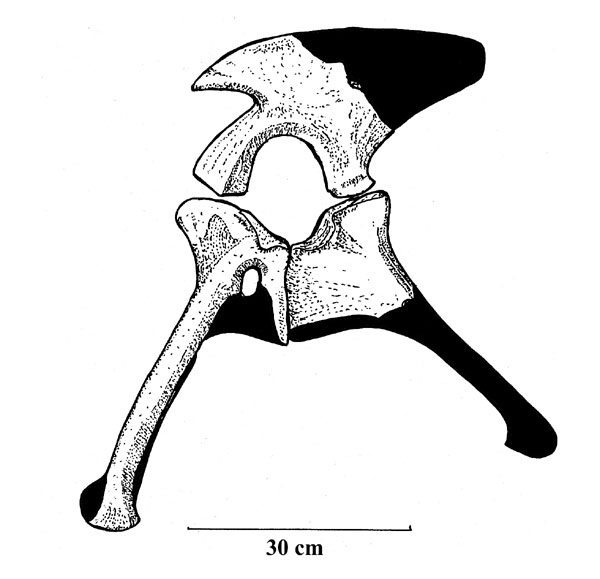BMNH R1312: Cast of a dorsal centrum.
BMNH R1312a: Cast of a phalangeal of the pes.
Neotype (as per YATES & BARRETT, 2010)
GOW, KITCHING & RAATH, 1990
Locality: Farm Bormansdrift (133), 28'57"S, 27'26"E, E. Map reference 2827CD, Mekoatlengsnek, Free State (Orange Free State) Province, South Africa.
Horizon: Upper Elliot Formation.
Biostratigraphy:
Age: Hettangian-Lower Sinemurian Stage, Lower Lias Epoch, Early Jurassic.
Material:
BP/1/4934: Large skull and fragmentary articulated skeleton. (presumed male).
Locality: Chelmer spruit on Chelmer Farm, about 15 miles from Bulawayo on the Nyamandhlovu road. The locality is marked by a star on the map (Macgregor et al. 1937). A second star on the same map a little distance farther downstream marks the place where Phaup (1932) found a few bone fragments at a slightly lower horizon. Zimbabwe.
Horizon: The middle division of the Forest Sandstone, but less than 100 feet below the base of the Karroo basalts.
Biostratigraphy:
Age: Late Triassic.
Material:
5216, 5218-5223: The greater part of the left side of the pelvis and an almost complete left hind leg and foot were excavated in situ. There are also some vertebra and fragments of other bones.
BARRETT, 2009
Locality: Near Voyizane Village, 30°34'S, 27°26'E, Herschel District, Eastern Cape Province, Republic of South Africa.
Horizon: Upper Elliot Formation.
Biostratigraphy:
Age: Either Hettangian to Sinemurian Stage, Lower Lias Epoch, Early Jurassic (OLSEN & GALTON, 2984) or Pliensbachian-Toarcian Stage, Upper Lias Epoch, Early Jurassic (YATES et al, 2004).
Material:
SAM-PK-K7904: Skull.
COOPER, 1981
Locality:
Horizon:
Biostratigraphy:
Age:
Material:
SAM-K1314: Skull.
QG43: Premaxillary fragment.
NMR7951: Premaxillary fragment and maxillary fragment.
QG21: Left ilium.
QG21c: Right tibia.
QG22: Left fibula.
QG29: First phalange and first manual ungual of first digit.
QG38: Humerus.
QG46: Right scapula, humerus, radius, ulna and manus of a juvenile, femur, .
QG51: Left scapula.
QG75: Right ilium.
QG77: Left ilium.
QG1158: Fragmentary neural arch.
QG1159: Eight cervical vertebra, metacarpal I.
QG1159: Last cervical vertebra, first dorsal vertebra, 12th and 13th dorsal vertebrae with rib, dorsal sacral vertebrae, third sacral and first caudal vertebrae, coracoid, cervical ribs, gastralia, scapulocoracoid, left? sternal plate, interclavicle, ilium, ischium, pubes, right femur, tibia, left fibula, astragalus, calcaneum, metatarsals.
QG1160: Phalanges of the manus.
QG1161: Femur.
QG1184: Astragalus.
QG1189: Middorsal rib, anterior chevron,
QG1191: Neural arch.
QG1192: Left ilium.
QG1254: Calcaneum.
QG1282: Metacarpal III.
QG1374: Midcaudal vertebra.
QG1384: Midcervical vertebra.
QG1385: Posterior caudal vertebra.
QG1389: Pes.
QG1390: Right radius.
QG1392: First pedal digit, first phalanx of the first digit.
QG1395: Right ulna.
QG1396: Humerus.
QG1389: Metatarsal V.
NMR5403: Distal end of fibula.
Number: Not given: Furcula.
Locality: Nyamandhlovu, Southcote Farm, Zimbabwe.Horizon: Forest Sandstone.
Biostratigraphy:
Age: Early Jurassic.
Material:
UCR9558: Manus and carpals.
GOW, 1990
Locality: South Africa.
Horizon:
Biostratigraphy:
Age: Late Triassic.
Material:
BP/1/5231: Fragmentary skull of a juvenile with braincase.
BP/1/5276 (BP-1-6276A, typo): Skull of an exceptionally large individual with a braincase.
GOW, KITCHING & RAATH, 1990
Locality: Farm Upper Drumbo, 30'50"S, 27'45"E map reference 3027DC, Barkly East, Eastern Cape Province, South Africa.
Horizon: 6 meters below Elliot/Clarens Formation.
Biostratigraphy:
Age: Hettangian-Lower Sinemurian Stage, Lower Lias Epoch, Early Jurassic.
Material:
BP/1/5241: Skull and fragmentary skeleton. (presumed female).
Note: Incorrectly listed as 5247 by GOW et al, 1990.
Locality: Blikana Mountain, 30'36"S, 27'37"E, Map reference 3027DA, Blikana, Transkei (Herschel) District, Eastern Cape Province, South Africa.Horizon: Middle Elliot Formation.
Biostratigraphy:
Age: Hettangian-Lower Sinemurian Stage, Lower Lias Epoch, Early Jurassic.
Material:
BP/1/4376 (BP-FN4376): Fragmentary skull, cervicals and hind limbs of a juvenile.
Locality: Farm Tevrede (1077) 28'32"S., 28'30"E, Map sheet 2828CB, Clarens, Eastern Cape Province, South Africa.Horizon: Lower Clarens Formation.
Biostratigraphy:
Age: Hettangian-Lower Sinemurian Stage, Lower Lias Epoch, Early Jurassic.
Material:
BP/1/4779: Skull and most of skeleton.
Locality: Farm Dennelaan, (148), 28'57"S, 27'27" E. Map sheet 2827CD, Mekoatlengsnek, Free State (Orange Free State) Province, South Africa.
Horizon: Upper Elliot Formation.
Biostratigraphy:
Age: Hettangian-Lower Sinemurian Stage, Lower Lias Epoch, Early Jurassic.
Material:
BP/1/4930: Skull, distal fibula and metatarsus.
Locality: Farm Twee Zusters, 29'03"s, 27'26"E, Map reference 2927AB Ladybrand, Free (Orange Free) State, South Africa.
Horizon:
Biostratigraphy: Tritylodon Acme Zone.
Age: Late Triassic.
Material:
BP/1/4998: Fragmentary skull and partial skeleton.
Locality: From the 'neck' on the boundary’s between Welbedacht and Edelweiss, 29'06"S, 19'10"E, Map reference 2927AB Ladybrand, Free (Orange Free) State, South Africa.Horizon:
Biostratigraphy: Euskelosaurus Range Zone.
Age: Early Jurassic.
Material:
BP/1/4952: Premaxillary tooth.
Locality: St. Michaels Mission, 30'30"S, 27'25E, Transkei (Herschel) District, Eastern Cape Province, South Africa.Horizon: Middle Elliot Formation.
Biostratigraphy:
Age: Hettangian-Lower Sinemurian Stage, Lower Lias Epoch, Early Jurassic.
Material:
BP/1/5293: Dentary fragment and several teeth.
KITCHING, 1979, REISZ, SCOTT, SUES, EVANS & RAATH, 2005, CHAPELLE, VERNANDEZ & CHOINIERE, 2020
Locality: Rooidraai (Red Bend), in the Golden Gate Highlands National Park, 17 km east of Clarens, Free (Orange Free) State, South Africa.
Horizon: Upper Elliot Formation.
Biostratigraphy:
Age: Hettangian-Lower Sinemurian Stage, Lower Lias Epoch, Early Jurassic.
Material:
BP/1/534/7b: 6 eggs containing fetal skeletons.
BP/1/5347A: Embryo skull and skeleton.
Note: Massospondylus sp?
Note: Mikhailov, 1997 states…A clutch of six subspherical eggs with mineralized
shells was collected from the Late Triassic Elliot Formation at Rooidrai, South
Africa (Kitching 1979). Poorly preserved remnants of embryos found in three of
the six eggs permitted the certain assignment of these eggs to dinosaurs. Skeletal
remains of the cynodont Tritylodon, the thecodontian Clarencea and
the prosauropod Massospondylus are known from the same locality. Initially,
Kitching did not attribute the eggs to any particular dinosaurian taxon, but
later they were assigned to Massospondylus as they were considered ‘too
large for Clarencea’ (Grine and Kitcing 1987, p. 616). It is necessary
to stress here that egg size 55 X 65 mm) and shell thickness (0.5 mm) are fare
below the range of any known sauropod and ornithopod eggshell. The eggshell structure
(Grine and Kitching 1987, text-figs 20-23) is very strange and possibly altered.
It is obviously different from that of the sauropods known from southern Europe,
India and South America (Megaloolithidae and a similar undescribed oofamily),
and from Central Asia (Faveoloolithidae), as well as from any ornithoid and crocodiloid
eggshell.
Note: ZELENITSKY & MODESTO, 2002 confurm that these eggs to belong to the
dinosauria and the crocodilian eggshell structure is due to diagenesis.
= Leptospondylus capensis OWEN, 1854 (nomen
dubium)
Etymology: In reference to Cape Province, South Africa.
Holotype: RCS
Locality: Beaucherf, Harrismith, Free (Orange Free) State, South Africa.
Horizon: Upper Elliot Formation.
Biostratigraphy:
Age: Hettangian-Lower Sinemurian Stage, Lower Lias Epoch, Early Jurassic.
Material: Imperfect vertebra.
Note: Destroyed.
= Pachyspondylus orpenii OWEN, 1854 (nomen dubium)
Etymology:
Holotype: RCS
Locality: Harrismith, Free (Orange Free) State, South Africa.
Horizon: Red Beds, Stormberg Series.
Biostratigraphy:
Age: Late Triassic.
Material: Imperfect vertebra.
Note: Destroyed.
= Hortalotarsus skirtopodus SEELEY, 1894
Etymology:
= Gyposaurus skirtopodus (SEELEY, 1894) KUHN,
1965
= Thecodontosaurus skirtopodus (SEELEY,
1894) HUENE, 1914
Holotype: Albany Museum 455
Locality: Barkely East Division, Barkely East District, (?)30'50"S, 27'45"E, Eastern Cape Province, South Africa.
Horizon: Clarens Formation, Stormberg Series.
Biostratigraphy:
Age: Hettangian-Lower Sinemurian Stage, Lower Lias Epoch, Early Jurassic.
Material: Right tibia and fibula, right 1st, 2nd and 3rd phalanges.

Referred material:
BOND, 1955
Locality: Dingaan Farm, Bubi District. The locality is marked by; a star on the map of the area (Macgregor et al. 1937), Zimbabwe.
Horizon: No more that 100 feet below the base of the Karroo basalt, probably in the upper division of the Forest Sandstone.
Biostratigraphy:
Age: Late Triassic.
Material:
5043 (originally A. 2188): Distal portion of a left fibula.
BROOM, 1911/HAUGHTON, 1924
Locality: Fountaine, Fourestburg, 28'40"S, 28'15"E, Free (Orange Free) State, South Africa.
Horizon: Upper Elliot Formation.
Biostratigraphy:
Age: Hettangian-Lower Sinemurian Stage, Lower Lias Epoch, Early Jurassic.
Material:
SAM 3429: Some vertebrae, a scapula, the distal end of a humerus, an ulna, ilium, part of an ischium, a femur and a tibia.
HUENE, 1906Locality: South Africa.
Horizon:
Biostratigraphy:
Age: Late Triassic.
Material:
Wiener Hofmuseum: Fragmentary dorsal vertebrae.
= Massospondylus browni SEELEY, 1895
Etymology: In honor of Alfred Brown.
= Thecodontosaurus browni (SEELEY,
1895) HUENE, 1914
Holotype: BMNH R3302
Locality: Telle River, Transkei (Herschel) District, Eastern Cape Province, South Africa.
Horizon: Upper Elliot Formation.
Biostratigraphy:
Age: Hettangian-Lower Sinemurian Stage, Lower Lias Epoch, Early Jurassic.
Material: 2 femora, 2 cervical vertebrae, a dorsal vertebra, 3 caudal vertebrae, and some foot bones.
Referred material:
van HOEPEN, 1920
Locality: Farm St. Fort, Letsoanastad No. 528 of 1905 map of Bethlehem District, Free (Orange Free) State, South Africa.
Horizon: Upper Elliot Formation.
Biostratigraphy:
Age: Hettangian-Lower Sinemurian Stage, Lower Lias Epoch, Early Jurassic.
Material:
Number: Not given: 5 cervical, all dorsals, 3 sacral, 11 caudal vertebrae, right scapula and coracoid, humeri, ulnae, radii, two carpalia, both mani, ilia, pubi, proximal portions of ischia, femora, tibiae, left fibula, tarsals, right pes and fragmentary left pes.
ELLENBERGER, 1970/KITCHING & RAATH, 1984Locality: Quthing, 30'24"S, 27'41"E, Lesotho, Southern Africa.
Horizon: Upper Elliot Formation.
Biostratigraphy:
Age: ?Hettangian-Lower Sinemurian Stage, Lower Lias Epoch, Early Jurassic.
Material:
Number: Not given:
= Massospondylus harriesi BROOM, 1911
Etymology: In honor of Mr. J. L. Harries, whos farm the specimen was found on.
Holotype: SAM 3394
Locality: Farm of Mr. J. L. Harries, Fountaine, Fouriesburg, 28'40"S, 28'15E, Free (Orange Free) State, South Africa.
Horizon: Upper Elliot Formation.
Biostratigraphy:
Age: ?Hettangian-Lower Sinemurian Stage, Lower Lias Epoch, Early Jurassic.
Material: Imperfect humerus, a nearly perfect radius and ulna, a perfect manus, as well as portions of the femur and tibia, and a number of toe bones all of one individual and the perfect pes of another individual.
Referred material:
BOND, 1955
Locality: Southcote Farm (on the road from Bulawayo to Nyammandhlovu); in a spruit about three-quarters of a mile southwest of the homestead, Zimbabwe.
Horizon: About 50-100 ft. below the base of the Karroo Basalts, in the white sandstone forming the Upper Division of the Forest Sandstone.
Biostratigraphy:
Age: Late Triassic.
Material:
7842, 7951: A practically complete left hand, with the distal halves of the radius and ulna.
Note: Found with gastroliths.
HAUGHTON, 1924
Locality: On a hill overlooking the Blikana Trading Store, Transkei (Herschel) District, Eastern Cape Province, South Africa.
Horizon: Upper third of the Red Beds, Stormberg beds.
Biostratigraphy:
Age: Late Triassic.
Material:
SAM 5135: The caudal region had weathered off and was not obtained but the remainder of the skeleton was found lying artictulated with the exception of the head, which was found lying about 3 feet from the neck, the skull is fragmentary.
HUENE, 1911Locality: Colesberg, South Africa.
Horizon:
Biostratigraphy:
Age: Late Triassic.
Material:
Number: Not given: Fragmentary pes.
KITCHING & RAATH, 1984Locality: Blikana Mountain, 30'34"S, 27'37"E, Transkei (Herschel) District, Eastern Cape Province, South Africa.
Horizon: Middle Elliot Formation.
Biostratigraphy:
Age: ?Hettangian-Lower Sinemurian Stage, Lower Lias Epoch, Early Jurassic.
Material:
SAM:
RAATH, 1980
Locality: Farm Mequatling (278), about 20 km WSW of the Town of Clocolan, just south of the Road between Clocolan and Excelsior, South Africa.
Horizon: Upper Elliot Formation.
Biostratigraphy:
Age: ?Hettangian-Lower Sinemurian Stage, Lower Lias Epoch, Early Jurassic.
Material:
QG691:
RAATH, SMITH & BOND. 1970
Locality: Tsetse Department base called Mana Pools Camp, with overlooks a small gorge in the lower Angwa River, just downstream of its confluence with the Maura River, Sipolilo district, Zimbabwe.
Horizon:
Biostratigraphy:
Age: Late Triassic.
Material:
QG21A: Femur, ilium, fragmentary ischia, fragmentary pubes, humerus.
SMITH, 1968Locality: South Africa.
Horizon: Forest Sandstone.
Biostratigraphy:
Age: Late Triassic.
Material:
Number: Not given: Right distal halves of tibia, fibula and complete foot.
= Massospondylus cf. harriesi BROOM, 1911
Locality: Near the homestead of Galeta's Farm, in a small tributary of the Umguza River called the Magonye. The locality is about 35 miles from Bulawayo near the Victoria Falls road. Zimbabwe.
Horizon: About 50 feet below the base of the Karroo Basalts, in the white upper division of the Forest Sandstone.
Biostratigraphy:
Age: Late Triassic.
Material:
6939: Distal half of metatarsal I, phalanx I and proximal half of claw, distal half of metatarsal II and phalanx I, phalanges 1, 2, 3 of digit III, distal part of metatarsal IV and Phalanges, 1, 2, 3, 4.
7345: At a later date more bones of the same individual were collected. These included vertebrae, complete right femur, right and left pubic bones, major part of an ischium, some ribs, further toe bones, distal ends of right radius and ulna. Among the ribs there was about a handful of small surrounded cherty pebbles, mostly about 1/2-1 inch in longest diameter.
= Aetonyx palustris BROOM, 1911
Etymology: Latin, palustris, "of the marsh."
Holotype: SAM-2768, 2769, 2770
Locality: Fountanie, Fouriesburg, 28'40"S, 28'15"E, Free (Orange Free) State, South Africa.
Horizon: Upper Elliot Formation.
Biostratigraphy:
Age: ?Hettangian-Lower Sinemurian Stage, Lower Lias Epoch, Early Jurassic.
Material: A few imperfect dorsal vertebrae, a good scapula and coracoid, humerus radius and fragmentary ulna, greater part of each manus, the upper end of one tibia and the almost complete right pes.
Referred material:
AMNH 5623: Cast of type humerus.
AMNH 5624: Shoulder girdles, vertebrae, manus and numerous other bones.
van HEERDEN, 1972
QR 652: Fragmentary skeletal elements.
= Gryponyx transvaalensis BROOM, 1912 (nomen dubium)
Etymology: In refernec to Transvaal, South Africa, the original name of the province.
Holotype:
Locality: Farm Wiepe (1258) on the Limpopo, Northern Province (formerly Northern Transvaal), South Africa.
Horizon: Bushveld Sandstone.
Biostratigraphy:
Age: Cave Sandstone, Late Triassic.
Material: Small part of the shaft of a femur, part of the head of a femur, part of a shaft of a tibia, small part of a fibula, part of the anterior acetabular portion of the left ilium, two or three fragments of metatarsals, including the perfect distal half of the second right metatarsal, the almost perfect right ungual phalanx, and the nearly complete centrum of a dorsal vertebra.

= Aristosaurus erectus HOEPEN, 1920
Etymology: Latin, erectus, "up right, erect."
= Gyposaurus erectus HOEPEN, 1920
Holotype: TM 130
Locality: Near Roosendal, Senekal District, Ficksburg, (?)28'30"S, 27'57"E, Free (Orange Free) State, South Africa.
Horizon: Clarens Formation, Stormberg Series.
Biostratigraphy:
Age: ?Hettangian-Lower Sinemurian Stage, Lower Lias Epoch, Early Jurassic.
Material: Almost complete skeleton and counter part.
= Dromicosaurus gracilis HOEPEN, 1920
Etymology: Latin, gracilis, "slender."
Holotype: TM 123
Locality: Naaupoork Nek, 2828ad Jordaan River, 28'29"S28'25E, Bethlehem District, Free (Orange Free) State, South Africa.
Horizon: Upper Elliot Formation.
Biostratigraphy:
Age: ?Hettangian-Lower Sinemurian Stage, Lower Lias Epoch, Early Jurassic.
Material: Fragmentary skeleton.
= Gryponyx taylori HAUGHTON, 1924 (nomen dubium)
Etymology: In honor of Mr. H. M. Taylor who helped find the specimen.
Holotype: SAM 3453
Locality: Fouriesburg, Fouriesburg, on Glen Skyre 121, (?) 28'37"S, 28'14E, Free (Orange Free) State, South Africa.
Horizon: Upper Elliot Formation.
Biostratigraphy:
Age: ?Hettangian-Lower Sinemurian Stage, Lower Lias Epoch, Early Jurassic.
Material: Pelvic girdle and sacral vertebrae.

Referred material:
ELLENBERGER, 1970/KITCHING & RAATH, 1984
Locality: Quthing, 30'24"S, 27'41"E, Lesotho, Southern Africa.
Horizon: ?Upper Elliot Formation.
Biostratigraphy:
Age: Hettangian-Lower Sinemurian Stage, Lower Lias Epoch, Early Jurassic.
Material:
Number: Not given:
= Massospondylus schwarzi HAUGHTON, 1924 (nomen dubium)
Etymology: In honor of Professor Schwarz who found the specimen.
Holotype: SAM 5134
Locality: Makomoreng, (?)30'11"S, 28'37"E, Transkei (Herschel) District, Eastern Cape Province, South Africa.
Horizon: Upper Elliot Formation.
Biostratigraphy:
Age: ?Hettangian-Lower Sinemurian Stage, Lower Lias Epoch, Early Jurassic.
Material: Incomplete pes and distal end of tibia.
= Thecodontosaurus dubius HAUGHTON, 1924
Etymology: Latin, dubius, "doubtful."
Holotype: SAM 3712
Locality: Ladybrand Townlands, Ladybrand, 29'12"S, 27'26"E, Free (Orange Free) State, South Africa.
Horizon: Clarens Formation, Stormberg Series.
Biostratigraphy:
Age: ?Hettangian-Lower Sinemurian Stage, Lower Lias Epoch, Early Jurassic.
Material: Larger portion of a skeleton.
Referred material:
van HOEPEN, 1915, 1920/HAUGHTON, 1924
Locality: Near Oresandal, Ficksburg, (?)28'30"S, 27'57"E, Free (Orange Free) State, South Africa.
Horizon: Clarens Formation, Stormberg Series.
Biostratigraphy:
Age: ?Hettangian-Lower Sinemurian Stage, Lower Lias Epoch, Early Jurassic.
Material:
Number: Not given: